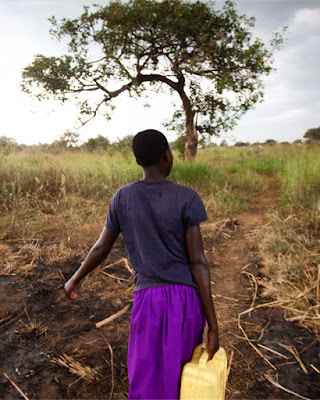Vulnerability and violence
As discussed in my previous posts, the traditional nature in which some women are expected to travel long distances to collect water subjects them to
the threat of sexual harassment. 80% of households where water collection is
not within close proximity to the home is carried out by women and girls (Kayser et al. 2019).
Furthermore, these women are threatened by sexual harassment when they are forced to
openly defecate due to a lack of sanitation provisioning. This threat is
heightened by cultural norms that deem it inappropriate for women to openly
defecate in the presence of people or at the risk of being seen. Hence, they
are obliged to do so when it is dark which is a more unpredictable and unsafe period
to be alone as a woman. In this post I am going to specifically look at cases
of sexual harassment arising during water collection alongside sexual harassment
that occurs as a result of a lack of basic sanitation facilities. Whilst there
is a variety of definitions around gender-based violence, this post will home in
specifically on the key factors of sexual violence (including ‘rape, assault,
molestation and inappropriate touching) and psychological violence (including ‘harassment,
eve-baiting, bullying or other actions that may cause fear, stress or shame’) (Sommer et
al. 2014: 107).
On average, African women dedicate a total of 200 million hours every day retrieving water
from near and distant sources (Pommells
et al. 2018). This time travelling on foot causes the potential for sexual
violence to occur from non-partners away from the safety of their home. However, it is perhaps too optimistic for me to refer to home as 'safe'. Many women are not always safe at home due to the potential
for sexual violence to occur from their partners if they have spent a long
duration of time out of the house in order to collect water (Ademun,
2009). A study conducted at Uganda Christian University, Uganda,
represented the voices of professionals within this area of gendered-violence in Uganda, Tanzania, Kenya and Rwanda (Pommells
et al. 2018). One of the focus groups discussed how ‘it is a generally
accepted practice of the community’ for rape to occur when women are collecting
water (Pommells
et al. 2018: 1854). This ties directly back to my post on time poverty
which highlights how one of the biggest challenges facing women is not the
accessibility of water, but the deeply embedded gender mindset that ‘allows’
this type of discrimination to occur without question. A key point arising from
a male focus group emphasised the vulnerability particularly of young girls who
are more desirable due to their virginity and status of being ‘clean’ (Pommells
et al. 2018: 1855). Furthermore, young girls are less aware of how to protect themselves and the
perception of them being ‘naïve’ further subjects them to potential violence (Pommells
et al. 2018: 1855). In another study focused in the Eastern Democratic Republic
of Congo (DRC), it was also confirmed that young girls are the most likely victims
of rape on their way to collect water. A UNICEF project calculated that between
June 2006 and May 2007, 12,867 individuals were raped in the eastern part of
the DRC of which 3,740 alone were young girls (Kirchner, 2007). However, this figure remains
under-representative as many incidences are not reported due to the inability
to seek medical help, or simply out of fear of the stigma of rape.
In addition to sexual harassment as a consequence of
travelling to collect water, the lack of suitable sanitation facilities for
women forces them to openly defecate in high-risk conditions. Open defecation
refers to the act of defecating in an open space as oppose to within a private
toilet. The majority of women who openly defecate do it at dawn or in the
evening due to cultural or religious pressure (Cairncross, 2003). Travelling
alone in the dark leaves women vulnerable to sexual harassment, such as in Kenya
where over 45% of women aged 15-49 have experienced some form of sexual
violence (Winter
and Barchi, 2016). A project studying the 2008 data of the Kenya
Demographic Health Survey uncovered that women who openly defecate in Kenya are
40% more likely to experience sexual violence from men who are not their
partners, demonstrating the risk that a lack of water and sanitation facilities
causes (Winter
and Barchi, 2016). Nonetheless, whilst open defecation submits women to sexual
threats, seldom is it the only cause of violence linked directly to sanitation.
Women may choose to openly defecate from fear of harassment in public
facilities where locks or doors from these private cubicles are missing (Khosla,
2000).
Public toilets donated by a charity in Kibera, Kenya. Source
Evidently, there is a direct link between water, sanitation
and the threat of sexual violence towards women in Africa. By looking at how
women are subjected to harassment from travelling for water, and similarly
through the act of open defecation, it is clear that the cultural gender norms of some African nations cause
double discrimination. Women are firstly discriminated on the basis of their expected
social position within the household with the tasks they are expected to carry
out, such as water collection. Secondly, they are discriminated further within these
roles where it is common within the culture for rape and sexual abuse to occur.
In my opinion, it is this second form of discrimination that is the most severe
as it is possible to install sanitation facilities through the help of international
aid projects, but it is a greater
challenge to alter the cultural norms of a society.





Comments
Post a Comment